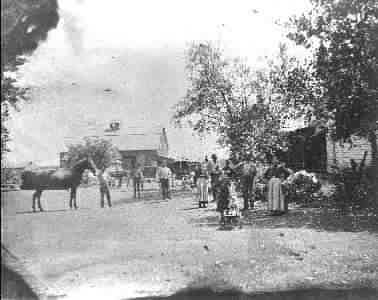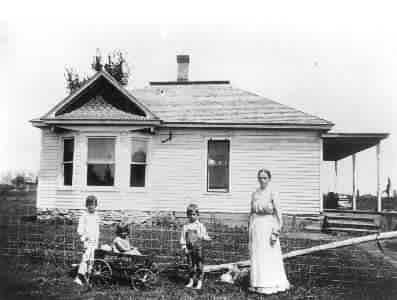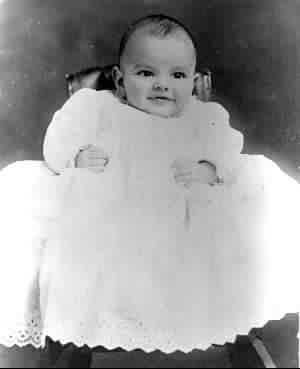Growing Up in Eastern Kansas
In writing down the recollections of my life, there no doubt
will be things I should say which I have omitted, and things  I
will say which I should not have said. My first memories are being part
of a large family, living in a rather small house. The house consisted
of three small bedrooms, a living room, and a dining and kitchen area.
It was heated with wood stoves, also the cooking was done with a wood burning
stove with a water reservoir and warming oven. It had a back porch with
a well under it.
I
will say which I should not have said. My first memories are being part
of a large family, living in a rather small house. The house consisted
of three small bedrooms, a living room, and a dining and kitchen area.
It was heated with wood stoves, also the cooking was done with a wood burning
stove with a water reservoir and warming oven. It had a back porch with
a well under it.
There were seven sons and four daughters. When we were
all around the dining table, it was quite a gang. Dad always led the talking
around the table. Mom was on the quiet side. Of course in my earlier years
the family wasnít that big. Since we lived on a farm there was always lots
of work to do. Each of us had our chores when we were old enough. Dad always
had cattle and some were for milking. When I was old enough I always got
in on that. Some were raised for beef, which was shipped to Kansas City
by train, and later by truck. We always had names for the milk cows. One
name I remember was "leather tit" and she was just that. It was hard to
get the milk to come. There were always lots of hogs, which Dad always
took care of. Mom always had chickens, the Plymouth Rock variety. Us kids
got in on gathering eggs. Donít remember ever seeing a hen laying an egg.
Always looked forward to having fried chicken on Sunday. When I was old
enough, I always got in on chopping their heads off and watching them flop.
Never had any qualms about it.
As far back as I can remember the folks had a telephone.
It hung on an outside wall and had a crank. We were on a party line. We
could listen in on neighborís conversation, but was frowned upon by our
parents. I remember to this day hearing the buzzing of the telephone wires
especially in the wintertime. The Indians called it the "talking wires".
For amusement us kids had lots of games we played including
ball games, like one-o-cat, hide and seek, pins down, anti over, leap frog,
and dare base. Also we played cricket a lot. In the wintertime there was
ice skating and sledding, playing fox and geese, shinny and having snowball
fights. Inside we had card games, hide the thimble, etc. I remember one
time Jay and I was skating on the creek. It was beginning to thaw. There
was an air hole, we were daring each other who could get the closest to
it. One of us finally hit it. We both went down through the broken ice.
We both got wet to our necks. We never wasted any time getting to the house.
Going fishing, looking for bullfrogs and crawdads, were
part of growing up. Eight-mile creek went through our folkís farm. No matter
how small the fish were, Mom was always patient about cooking them. Frog
legs were a real treat. We would even save the meat in the tail of large
crawdads. When we were fishing or just messing around the creek and ponds,
we had to be careful about snakes. There were lots of them. Once in a while
we would see a cotton mouth moccasin. Itís a wonder one of us hadnít been
bitten. There were three ponds on the George Curtis farm we fished in a
lot. They were across the road.
 Sand
Creek School that we attended was one mile east of our place. We walked
a big part of the time. My first year was 1918-1919. Lena Hutchins was
my first teacher. The school was one mile north and one mile west of Ottawa.
One of my teachers, Almira Harrison, later became my Aunt by marriage.
Sand
Creek School that we attended was one mile east of our place. We walked
a big part of the time. My first year was 1918-1919. Lena Hutchins was
my first teacher. The school was one mile north and one mile west of Ottawa.
One of my teachers, Almira Harrison, later became my Aunt by marriage.
It was about 1920 or 1921, Dad sold water from the California
Springs which was located on land which my grandfather, Ed Hume, purchased
in the late 1800ís. It became my mothers when my grandfather died in 1919.
The first year the water was delivered by team and wagon. My oldest brother,
Ed, delivered the water and I accompanied him to hold the reins while he
carried the water in, which was in a five-gallon glass container enclosed
in a wooden crate. It was sold for 25 cents per bottle. After the first
year, Dad bought a Model T Ford truck with a double deck bed on the back
to deliver the water. Bonnie drove the truck and did the delivering. When
Ottawa developed a water system, my Dads water business went down the drain.
Grammar school was the extent of my formal education. I guess I educated
myself somewhat by reading a lot and keeping up on the daily news. I donít
know whether the folks felt they couldnít afford to send us kids on to
school or didnít think it was necessary. My mother received only a grammar
school education and Dad only went through the fourth grade. The period
from the time I was through school until I left home, I helped on the folkís
farm the home place consisted of 80 acres and 240 acres known as the California
Springs farm. Most of it was pasture and hay meadow. In those times the
hay was put up loose. It was virgin prairie.
The springs farm got its name from the early travelers
going west to Santa Fe and California. Sunken places were still there when
I was young. They were worn down by the wheels of the many wagons leading
west. Because of the springs, it became a camping place for the early travelers.
There were double tracks. I donít know whether these sunken tracks can
still be seen or not.
We had alfalfa hay on the home place as well as corn and
wheat. The work was done by horses. I remember plowing with a walking plow
long before I was out of school. Husking corn in the fall was always a
big job. I always used a peg. Jay was a much better picker than I. He used
a hook. We helped some of our neighbors with their corn. I liked to chop
wood much better than pick corn. Since we heated the house with wood burning
stoves, and cooking was done with wood heat, it took a lot of work each
year.
 One
thing I always remembered is butchering time. Never a year passed when
I was young that dad didnít butcher hogs. Sometimes two or three neighbors
would butcher together. At the end of the day, hogs would be hanging from
limbs of trees for cooling out. They would be high enough so dogs or coyotes
couldnít reach them. Early in the morning on butchering day, Dad would
place two green logs together about two feet apart with a scalding vat
on top partly filled with water. A fire would be built under the vat. The
first hog wouldnít be killed until the water in the vat was to the scalding
point. The purpose of scalding the hog, it caused the hair to separate
from the skin much easier. I would get in on scraping the hair off if I
wasnít in school. The cutting up would take place the next day or so. Butchering
would have to be done on a fairly cold day. The meat was cured in various
ways. One of the ways the folks used a lot was the brine cure. Dad had
a smokehouse for smoking hams. Mom made a lot of sausage and some mincemeat.
And the fat had to be rendered into lard. Didnít know much about cholesterol
back then. Donít remember Dad butchering beef but once or twice.
One
thing I always remembered is butchering time. Never a year passed when
I was young that dad didnít butcher hogs. Sometimes two or three neighbors
would butcher together. At the end of the day, hogs would be hanging from
limbs of trees for cooling out. They would be high enough so dogs or coyotes
couldnít reach them. Early in the morning on butchering day, Dad would
place two green logs together about two feet apart with a scalding vat
on top partly filled with water. A fire would be built under the vat. The
first hog wouldnít be killed until the water in the vat was to the scalding
point. The purpose of scalding the hog, it caused the hair to separate
from the skin much easier. I would get in on scraping the hair off if I
wasnít in school. The cutting up would take place the next day or so. Butchering
would have to be done on a fairly cold day. The meat was cured in various
ways. One of the ways the folks used a lot was the brine cure. Dad had
a smokehouse for smoking hams. Mom made a lot of sausage and some mincemeat.
And the fat had to be rendered into lard. Didnít know much about cholesterol
back then. Donít remember Dad butchering beef but once or twice.
When I was a kid, I always liked to go barefoot. Our feet
would get so tough we could walk on most anything. When it was muddy after
a rain I liked to wade in the mud and feel the mud ooze between my toes.
Us boyís worked for the neighbors a lot. We got a little spending money
that way. I guess the first job I ever had was for George Curtis, our close
neighbor to the east. Part of his land was across the road from Dadís place.
His house and buildings were up the hill about a quarter of a mile. He
kept his milk. He kept his mild cows in a pasture across the road from
our house. When I was eight or nine years old he got me to drive his cows
up to his barn in the evening for milking. He gave me ten cents a week.
When he turned his cows into the corn stalks after the husking was done,
he raised my salary to twenty cents per week. I thought I was doing pretty
good. We also made a little money trapping for bearing animals, like muskrat,
skink, and opossum. We got anywhere from fifty cents to a dollar and a
half for each pelt.
Pictures
-
The E.W.Hume farm in Franklin County, Kansas. The original was a
tintype whose image was reversed. This copy is not reversed. Left
to right: Horace Buckles (a hired hand), Oscar Deaton (a hired hand),
Jay Hume, Aunt Line, Ernest Hume, Flossie Hume, Jennie Hume, Edward Hume,
and Rachel Hume. Jennie Hume was born in 1879, so this picture would
have been taken in about 1895.
-
Taken about 1909 at the Jack & Jennie Home Place. Left to right:
Edward, Mary and Bonnie Crawford and their mother Mrs. Jennie E. Crawford.
-
Earl Woodrow Crawford. Age 4 months, 20 days. This would be
on December 16, 1912. Weight 18 lbs.
 Sand
Creek School that we attended was one mile east of our place. We walked
a big part of the time. My first year was 1918-1919. Lena Hutchins was
my first teacher. The school was one mile north and one mile west of Ottawa.
One of my teachers, Almira Harrison, later became my Aunt by marriage.
Sand
Creek School that we attended was one mile east of our place. We walked
a big part of the time. My first year was 1918-1919. Lena Hutchins was
my first teacher. The school was one mile north and one mile west of Ottawa.
One of my teachers, Almira Harrison, later became my Aunt by marriage.
 I
will say which I should not have said. My first memories are being part
of a large family, living in a rather small house. The house consisted
of three small bedrooms, a living room, and a dining and kitchen area.
It was heated with wood stoves, also the cooking was done with a wood burning
stove with a water reservoir and warming oven. It had a back porch with
a well under it.
I
will say which I should not have said. My first memories are being part
of a large family, living in a rather small house. The house consisted
of three small bedrooms, a living room, and a dining and kitchen area.
It was heated with wood stoves, also the cooking was done with a wood burning
stove with a water reservoir and warming oven. It had a back porch with
a well under it.
 One
thing I always remembered is butchering time. Never a year passed when
I was young that dad didnít butcher hogs. Sometimes two or three neighbors
would butcher together. At the end of the day, hogs would be hanging from
limbs of trees for cooling out. They would be high enough so dogs or coyotes
couldnít reach them. Early in the morning on butchering day, Dad would
place two green logs together about two feet apart with a scalding vat
on top partly filled with water. A fire would be built under the vat. The
first hog wouldnít be killed until the water in the vat was to the scalding
point. The purpose of scalding the hog, it caused the hair to separate
from the skin much easier. I would get in on scraping the hair off if I
wasnít in school. The cutting up would take place the next day or so. Butchering
would have to be done on a fairly cold day. The meat was cured in various
ways. One of the ways the folks used a lot was the brine cure. Dad had
a smokehouse for smoking hams. Mom made a lot of sausage and some mincemeat.
And the fat had to be rendered into lard. Didnít know much about cholesterol
back then. Donít remember Dad butchering beef but once or twice.
One
thing I always remembered is butchering time. Never a year passed when
I was young that dad didnít butcher hogs. Sometimes two or three neighbors
would butcher together. At the end of the day, hogs would be hanging from
limbs of trees for cooling out. They would be high enough so dogs or coyotes
couldnít reach them. Early in the morning on butchering day, Dad would
place two green logs together about two feet apart with a scalding vat
on top partly filled with water. A fire would be built under the vat. The
first hog wouldnít be killed until the water in the vat was to the scalding
point. The purpose of scalding the hog, it caused the hair to separate
from the skin much easier. I would get in on scraping the hair off if I
wasnít in school. The cutting up would take place the next day or so. Butchering
would have to be done on a fairly cold day. The meat was cured in various
ways. One of the ways the folks used a lot was the brine cure. Dad had
a smokehouse for smoking hams. Mom made a lot of sausage and some mincemeat.
And the fat had to be rendered into lard. Didnít know much about cholesterol
back then. Donít remember Dad butchering beef but once or twice.